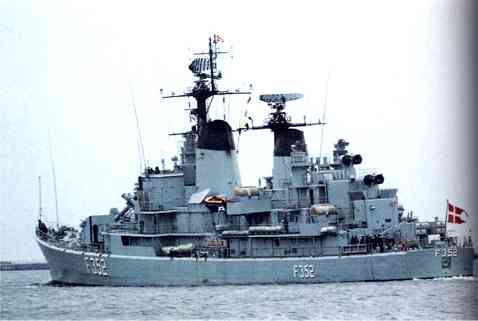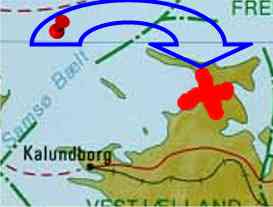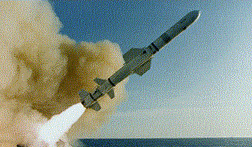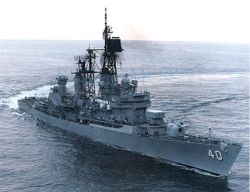|
You are here: 4Campaigns & Battles4Index4Missile Incident at Lumsaas |
|||||||||||||||||||||||||||||||||||||||||||||||||||||||||||||||||||
|
Missile Incident at Lumsaas (1982):
HARPOON
missile
|
||||||||||||||||||||||||||||||||||||||||||||||||||||||||||||||||||
|
Just after the impact, there were a great deal of confusion to what could have caused the explosion. Several witnesses had seen something coming out of the sky, and they feared that a plane had crashed. As the first rescue workers arrives at the scene, there were still no clear picture of, what had cause the explosion. The commanding officer of the frigate PEDER SKRAM, Commander s.g. Jens L. Winther, had in the meantime informed the Naval Tactical Command in Aarhus, that a HARPOON missile |
The
HARPOON missile strikes a |
had been accidentally launched.
The Naval Artillery School, placed at Sjællands Odde (Around 20 kilometers from Lumsaas), was also immediately informed of the incident by the frigate. And the artillery school could just after noon confirm, that the missile had hit an area close to Lumsaas.
Personnel from the Naval Artillery School were later involved in the clean-up operation.
The Incident occurred during routine exercises
|
Commander s.g. |
The frigate PEDER SKRAM, commanded by Commander s.g. Jens L. Winther, was on a routine sail from Aarhus to join a NATO exercise in the Baltic area. Before leaving Aarhus did the frigate, among others, receive a number of spare parts for the missile system. The frigate was cruising steadily at a speed of around 20 knots in south easterly direction (course 075). On board were the crew of more than 200 men, but also one of the most experienced missile experts in the navy were on board on this sail. This expert was Commander Henning G. Olsen from the Naval Material Command. The Commander was just performing the final functional tests of the missile system, after replacing several parts. |
When the launch took place at 1128, the frigate was located in the southern part of the Kattegat, 10 nautical miler, or around 19 kilometers, northwest of Sjællands Odde.
The HARPOON missile ended its flight 34 kilometers from this position in an almost deserted summer residential area at Lumsaas, on the north western coast of Zealand.
The impact happened before the missile had started an active search.
The missile warhead detonated just 5 meters above the ground and caused severe material damage.

The guided missile frigate
PEDER SKRAM
(Photo:
Royal Danish Navy)
Ups! - What was that?
Immediately after the launch, there was great uncertainty on board the frigate to what had happened.
|
No doubt, that the launch opened the eyes on the officer on duty. The HARPOON missile launchers are placed just in front of the bridge. In the wardroom they were getting ready for lunch, when the after shock from the launch made heavy vibrations throughout the ship. It became almost instantly obvious, that one of the HARPOON missiles had been launched. The operations officer, Commander Ulrik Wesche, remembered that during the morning several men had been working on the fore deck of the frigate, and immediately he feared the worst. He, the 1st officer and the ships doctor moved on |
The Operations Officer, |
the double the short distance from the Wardroom to the fore deck.
Great relief, when they noted, that no one was injured, - but at the same time realizing that a HARPOON missile had been launched for unknown reasons.
All they could do was waiting! Just wait to find out where and what the loose missile would eventually hit. Everyone on board feared the worst and hoped for the best.
Just 4 minutes later the missile on the loose ended its flight.
Following the event, a former communist member of the Danish Parliament publicly stated in the Parliament: "Personally, I don't like the way our defense is effecting slum clearance..."
Frigates of the PEDER SKRAM Class
|
The guided missile frigate
PEDER SKRAM, |
PEDER SKRAM and the sister ship HERLUF TROLLE was the largest ships of the Royal Danish Navy, and actually became the last frigates to serve the navy for a period. PEDER SKRAM was 112 meters long and had a displacement of 2,400 tons. It was built at Helsingør and commissioned on May 25, 1966. The PEDER SKRAM Class was revolutionary in design when |
originally launched. The ships became the first large warships to be equip-ped with gas turbines as the primary propulsion.
The gas turbines could give the frigates a maximum speed exceeding 28 knots, or more than 52 kilometer an hour.
From June 1977 to July 1979 the PEDER SKRAM went through a moderni-zation and update, including a rearmament, turning the ship into a modern guided missile frigate.
HERLUF TROLLE had been refitted just one year ahead. The guided missile frigates were now armed with 8 HARPOON SSM missiles and a launcher for Sea Sparrow SAM missiles.
However, on September 6 the frigate only carried 4 of these missiles.
The HARPOON missile
The HARPOON was originally produced by McDonnell-Douglas in the USA, today part of the Boeing Company, and is widely used as the standard surface-to-surface missile (SSM) among the NATO countries, including Denmark.
|
The missile system was introduced in the Danish navy in 1979 and became the standard SSM system for the frigates. HARPOON was also the standard SSM system for the corvettes of the NIELS JUEL Class, and the former torpedo boats of the WILLEMOES Class. To day the system, in an updated version, is one of the modules, that can be made operational in the FLYVEFISKEN Class. |
A HARPOON missile is launched |
The guided missile, which is 3,8 meters long and weighting more than 500 kilograms, has a range of more than 60 nautical miles, or around 120 kilometers.
Reaching a speed of mach 0.85 (around 281 meters a second), the missile can be preprogrammed to certain altitudes and maneuvers before launch.
Normally it carries a 220 kilogram high explosive warhead.
Technical or Human Error?
What caused this missile launch during the functional tests? - Was it technical, or was it a human error.
The Naval Material Command, who was the main responsible for the imple-mentation of the HARPOON system, immediately started an internal research to clarify possible causes.
Quite fast it was made clear, that one or several technical causes could have caused the launch. Technical problems that could also happen to the other HARPOON missile systems in the navy.
It was therefore decided, that until further notice, all HARPOON missile system should immediately be made inoperative by disconnecting the cables to the system.
Tuesday, the day following the incident, the Naval Judge Advocate could inform Commander H. G. Olsen, who had performed the functional test on board the PEDER SKRAM, that the launch was caused by one or more technical failures, as he (Olsen) could not be made responsible for.
Commander Olsen admits technical misdemeanors
Commander Henning G. Olsen, who on this day had performed the func-tional tests on board the PEDER SKRAM, was the Danish Navy's greatest expert in this area.
During the last couple of years he had been testing the missiles hundreds of times, and the functional test preformed, was just one of the day-to-day routines.
This Monday in September, however, an astonished and chocked Comman-der Olsen had to face the fact, that something that could not happen, actu-ally happened.
A 500 kilo missile with a 200 kilo explosive charge had left its canister at the frigate PEDER SKRAM, and was heading somewhere in Denmark by almost supersonic speed.
Commander Olsen never tried to hide, and admitted clearly, that he might have ignored some blinking lights, that should have made him interrupt the ongoing functional testing.
But to Olsen it was left without doubts; the official manuals stated clearly that no launch, in any way, could be performed, without the special Launch Key placed and turned in the control panel.
During this days functional tests, the Launch Key were place at a safe place, in the commanding officers safe! Way from the control panel.
Not the first accident with a HARPOON missile
|
The American Guided Missile Destroyer |
This late summer day when a missile on the loose was head-ing for a Danish residential area, was not the first time a HARPOON missile decided to go on a way of its own. A year before, on July 14, 1981, the United States Navy had experienced a much similar incident. During an almost similar func-tional test of the HARPOON system on board the American guided missile destroyer COONTZ stationed in the Caribbean Ocean, the ship accidentally launched a HARPOON missile. The missile immediately flew |
over the horizon and disappeared. No impact or damages were ever reported.
The incident was almost immediately categorized as a human error.
McDonnell Douglas, the manufacturer of the missile system, informed the US Navy shortly after, that there was a risk of launch failures, if the procedures in the manuals were not followed precisely.
The US incident was unknown to the Royal Danish Navy, and thereby made no changes to the standard operational procedures.
Just suddenly also a Danish human error
Naval Judge Advocate, Mogens Reimann had previously informed Comman-der H. G. Olsen that his immediate judgment was, that the launch was caused by a technical failure.
Exactly one week after the incident, the Naval Judge Advocate was most surprisingly informed by the Chief-in-Command of the Naval Material Com-mand, Rear Admiral Mads E. Michelsen, that to the best of his judgment, the launch was caused by a human and not a technical error.
Most instantly, the officials in charge, civilians and military, stated that it must have been a human error!
The Danish government decided to set up a Commission Court (court of inquiry) to closely investigate the event.
|
Commander Henning G. Olsen
on his way |
The Scapegoat The commission court did rather quickly designated a scapegoat! Commander Henning. G. Olsen, RDN, on board the PEDER SKRAM, was made the main and solely responsible for the HARPOON launch, and charged. He had to pay the price, even a high human price. Quite fast the Commission Court stated, that Comman-der Olsen has acted been acting contrary to the manual for the HARPOON system and |
that his operations the present day, was to be described as superficially and insufficient, and that his lack of response to the the indications on the control panel was to be considered irresponsible.
The Commission Court found, that Commander Henning G. Olsen by his conduct had acted in a way, that he had shown an obvious dereliction of duty.
No one else were made responsible for the incident, and no blame was mad on the manufacturer McDonnell Douglas.
Humbug or facts
The Commission Court didn't even take into its considerations that the US Navy, prior to the Danish incident, had at least one similar incident with the HARPOON missiles from one of its ships (the USS COONTZ).
It is also a fact, that a number of documents related to this case were made not available, some documents even disappeared for a time being. Some documents were, just suddenly, "classified" as Secret without ever fulfilling the criteria to be classified.
Due to the massive criticism following the official report published 9 months after the Commission Court had finished its work, it was politically decided to set up the 2nd Commission Court.
This report form the 2nd Commission Court, published in July 1984, once again stated that Commander Olsen still was the guilty part.
At the same time, it was conclude, that the court found no basis to prose-cute any other responsible, due to the statue of limitations in the Military Penal Code!
|
Three Danish Journalists awarded Distinguished Prize Was it a technical malfunction, or just a combination of several human and technical errors leading to the launch, or did the parties who were really responsible just want someone else to blame?. The story is that in 1985, three years after the incident, the Danish journalists Allan Graubaek, Gunner Nielsen and Henrik Thomsen was awarded the CAVLING prize (the Danish equivalent of the Pulitzer Prize) for there in-depth coverage of the missile incident on the frigate PEDER SKRAM in September 1982. The motivation for awarding this distinguished prize to the three journalists was the in-depth research of the incident, which actually led to the establishment of a second commission court. |
The Cavling |
This second commission court reduced the charges against commander H. G. Olsen to almost nothing.
Who said EXOCET?
To a lot of people it might looks remarkably that it was so important to certain circles of high ranking politicians and naval officers to state that a human and not a technical failure caused the accidental missile launch.
This statement was made, despite the first announcement from the Naval Material Command clearly stated at the launch was caused by a technical failure. The Naval Judge Advocate made the same initial conclusion.
- But maybe much larger economical and political interest were at stake back in 1982?
No doubt, the HARPOON missile system, even to day, is an effective weapons system, and has proven its accuracy and reliability.
Way back in 1982 there was an intense debate on which missile system to become the new standard system in the NATO forces.
Some NATO countries, not at least the USA, were making the HARPOON system a clear favorite, while others wanted to make the French EXOCET the obvious choice.
The (Federal) German Navy had already begun the implementation of the French EXOCET missile system onto their ships.
The British, the Royal Navy, had most recently had some very dearly ex-periences with EXOCET missile. - June 1982 marked the end of the Falkland War, where most Royal Navy losses were caused by EXOCET missiles.
In mid summer 1982 there was no doubt, The EXOCET missile system worked! - Would the American competitor need an inexplicable technical failure?
Epilogue - Compensation is fulfilled
One Danish Commander was made solely responsible for this incident, and had to accept the "punishment".
For the second time his was played guilty by the Commission Court, stating the accidental launch was caused solely by a human error.
Commander Henning G. Olsen remained the only accused, and accepted the charge.
- No one else could be blamed!
One might wonder, why the Danish government subsequently took legal action against McDonnell Douglas at St. Louis, USA with a claim for compen-sation?
This legal action ended with a compromise! - The McDonnell Douglas agreed to pay a sum of money to the Danish Government.
The sum, as a coincidence, were just the same amount the Danish Government had agreed to pay as a compensation to the owners of the destroyed or damaged weekend cottages at Lumsaas!
|
Sources: |
||
|
& |
Beretning afgivet af KOMMISSIONSDOMSTOLEN af 11. oktober 1983 vedrørende Harpoon-missilulykken den 6. september 1982, Copenhagen, 1983 |
|
|
& |
Beretning afgivet af KOMMISSIONSDOMSTOLEN af 9. juli 1984 vedrørende Harpoon-missilulykken den 6. september 1982, Copenhagen, 1984 |
|
|
" |
The daily newspaper POLITIKEN's website http://www.politiken.dk |
|
|
& |
Flådens skibe og fartøjer 1945-1995, by Gunnar Olsen and Svenn Storgaard, Marinehistoriske skrifter, Copenhagen, 1998 (ISBN 87-87720-13-2) |
|
|
& |
|
|
|
& |
Vildskud, Bogen om missil-sagen, by Gunner Nielsen and Henrik Thomsen, Forlaget Systime A/S, 1984 (ISBN 87-7351-267-2) |
|
|
" |
Some of the photos have previously been published by Holbæk Amts Venstreblad, and are put to my disposal by courtesy of this daily newspaper: The pictures mentioned, are reproduced by authorization from the Holbæk Amts Venstreblad |
|
|
44You are also referred to the Naval Bibliography |
||
![]()
![]()
The
Danish frigate
PEDER SKRAM is today an open museum
based at Naval Station Copenhagen, Denmark.
If
you would like to know more of the frigate PEDER SKRAM
as a living museum, click here!
![]()
- Do you miss a major event on this Site,
or do you hold a great story?
Are you able to contribute to the unfolding of
the Danish Naval History,
please
e-mail
me, enclosures are welcome.
Please remember to list your sources.
You can also use the Naval Web Forum on this web-site.
![]()
|
MORE IN-DEPTH STORIES FROM |
|
The Explosion in Flensburg (1945) - Kieler Expeditionary Force (1945) - JUTLANDIA in Korea - Somebody just had to do it - NARHVALEN reported missing in the Skagerrak (1970) - The Battle off Gedser (1980) - Missile Incident at Lumsaas (1982) |
|
THE TOPIC STORIES: |
|
- Wars against England (1801-1814) - Reconstructing the Navy (1814-1848) - The 1st Schleswig War (1848-50) - The interim War Years (1850-64) - The 2nd Schleswig War (1864) - The long Period of Peace (1864-1914) - The Navy during the 1st World War (1914-1918) - The Interim Years (1919-1939) - The Navy during the 2nd World War (1939-1945) - The Cold War Period (1945-1989) - |
|
SEE ALSO: |
-
This page was last updated: October 20, 2002
This page was first published: July 29, 2001
Copyright © 2013-2016 Johnny E. Balsved - All rights reserved - Privacy Policy










